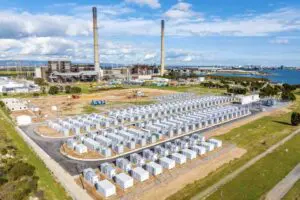Listed renewable energy developer Windlab says its unique wind, solar and battery hybrid project in north Queensland faces further delays into 2020 because its EPC contractor has failed to secure a connection agreement.
The Kennedy Energy Hub has been hailed as a world-leading project that comprises 43.5MW of wind energy, 15MW of solar and a 4MWh Tesla battery – and is the first to combine all three technologies on a major grid. It has plans to grow to a massive 1200MW over the long term – but while it has been mechanically complete since late last year, it is yet to begin production.
It now faces a longer wait after discovering that its contractor had been unable to secure a “fully functioning generator performance standard”, and would not likely do so until December. That would push the start of generation into 2020.
“AEMO (the Australian Energy Market Operator) is unable to register the project as a generator until a compliant GPS is prepared and approved,” Windlab said in a statement.
“Commercial operation of the project will now be delayed into 2020.”
It is not known what the specific problems at Kennedy are, although the company has cited the complexity of being required to add machinery including a statcom and a synchronous condenser to its project to deal with system strength issues, and lamented the strict new connection regime.
Issues first came to light in February when Windlab declared “force majeure” on its contract to deliver power to CS Energy, citing connection problems, the performance of its EPC contractor, and flooding from the recent cyclone events, which prevented access to the site by network commissioning crews.
In June, Windlab reported further delays because of the connection issues but expressed hope that this would occur by the end of September, and in August Windlab said the project had been “energised” and hoped to formally register as a generator in September.
A few weeks later it received a shock when AEMO, in a note to its annual forecasts for demand and supply, indicated it may not start generating until the middle of 2021, and declared that AEMO was being too pessimistic.
Windlab will seek further compensation through the EPC contractor, previously identified as a joint venture between Quanta Solar and Vestas. It claimed $2.6 million in the form of liquidated damages in June half for lost revenue for its share of the project, and it is presumed its 50 per cent partner, the Japanese-based Eurus Energy, did the same.
Claims for liquidated damages as a result of connection or commissioning delays have become common place. Genex laid a claim of $2.4 million for delays at its 50MW Kidston solar project in Queensland, and Infigen made a claim of $10 million over issues at its Bodangora wind facility in NSW.
Leading contractor RCR Tomlinson was the biggest victim of these delays, ultimately going out of business, but numerous other contractor have also been affected, including Downer, Bouygues, and others.
The changes in marginal loss factors, due to over-building in certain parts of the grid, is also causing problems. UK group John Laing has announced a write-down of $120 million on some of its projects in Australia and brought to a halt any further investment pending more certainty from regulators and rule makers.
AEMO currently warns that there can be a delay of 18 months between “energisation” and full connection to the grid.
Windlab CEO Roger Price in August lamented the growing number of issues facing wind and solar developers in Australia, including policy uncertainty, connection problems, and MLFs.
“There has been a dramatic shift to way that projects have been developed and connected to the grid, affecting many areas of the market,” Price told an investor briefing. “The market is now nervous about potential cost overruns, and the delays caused by grid connection processes and connection problems.”










